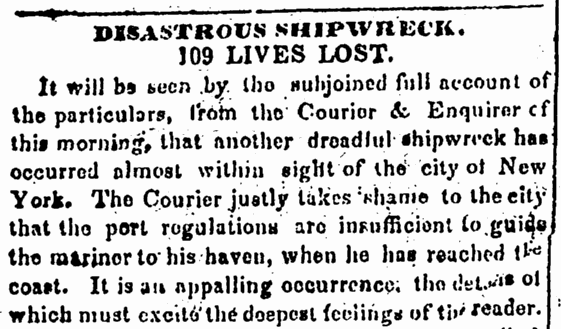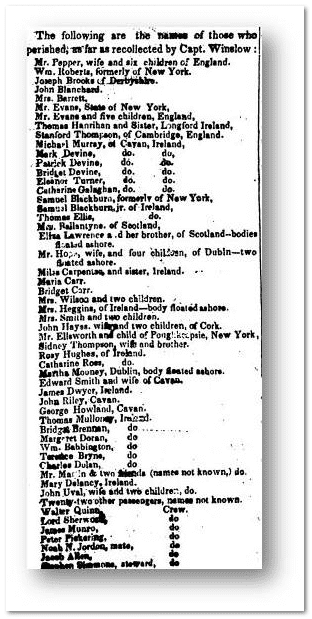Our ancestors have made the long trip to America starting with the days of the Pilgrims. These were not easy journeys and some ended in disaster. Here is a riveting newspaper account from an article written in 1837 showing just how brutal the trip to America could be.

The barque Mexico left Liverpool, England, in October 1836 with a 12-man crew and 104 passengers on board. Two-thirds of the passengers were women and children.
Two months after departing, the ship made it to the coast of New Jersey on Saturday, December 31, 1836. But, like an airplane waiting for the designated gate to open, the Mexico had to sit offshore with another “thirty or more square rigged vessels” waiting for a guide ship to pilot them in to the docks.
The sea was rough that day, and a gale-force wind blew them fifty miles from the port. It was now January 1837, the weather was not cooperating, and half the crew “were badly frost-bitten.” They could only remain above deck for 30 minutes at a time.
Soundings were taken but were not accurate. As the newspaper article explains: “The event has shewn that the information given by the mate as to the depth of water was incorrect; his error probably arose from the lead line being frozen stiff at the time it was cast.”
The captain, thinking that the water was deep enough for him to remain in place, dropped anchor. But as the tides shifted the ship “struck the bottom, 26 miles east of Sandy Hook at Hempstead beach, and not more than a cable’s length from the shore.”
A bad situation for the ship out at sea was growing worse… “The scene that ensued on board, we leave to the reader’s imagination.”
The Mexico’s life boats were deployed, but they were quickly smashed by the pounding waves. Finally a rescue boat came out from the shore to help the stricken ship and eight men—including Captain Winslow—jumped in and headed back to shore, escaping the Mexico.
What? The captain was one of the first to desert the ship?
The remaining ship passengers and crew, despite the fierce cold, gathered on the deck—watching the shore to see if more rescue boats would come out to save them.
None did.
“When they perceived that no further help came from the land their piercing shrieks were distinctly heard at a considerable distance, and continued through the night until they one by one perished.”
Their remains were found in the morning “lashed to different parts of the wreck embedded in ice.”
“None, it is believed, were drowned, but all frozen to death.”
The Newark Daily Advertiser published the Mexico’s sad shipwreck story, including a list of the passengers who died.
GenealogyBank gives you the news as your ancestors’ lived it.


great article
Wow. How awful. Situations like this were not uncommon, though. Even today we have captains jumping ship and leaving passengers behind.
Sad for all those people. I’ve read about a few NJ shore wrecks where similar fates befell the passengers.